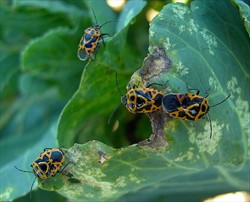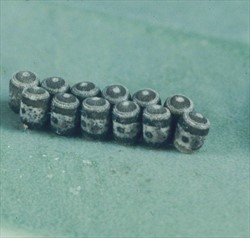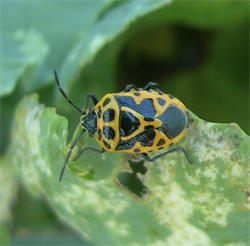Small cabbage bug; also known as the cabbage shield bug and cabbage stink bug.
Pacific Pests, Pathogens, Weeds & Pesticides - Online edition
Pacific Pests, Pathogens, Weeds & Pesticides
Cabbage small cabbage bug (536)
Eurydema pulchrum. Another species, Eurydema rugosum, cabbage bug, is similar, but its distribution is different. It is not recorded from Southeast Asia. The bugs belong to the Pentatomidae, shield or stink bugs.
Asia, Oceania. It has been recorded from West Papua (Irian Jaya) and Papua New Guinea.
Cabbage, radish, and other members of the mustard family (Brassicaceae), including wild species. Wasabi (Eutrema japonicum) is also a host.
The nymphs and adults do the damage. The bugs use their stylet mouth parts to pierce the surface of the leaf and suck out the contents of cells below. Initially, cream-coloured areas radiate from the point of feeding, giving a delicate flower-like appearance. Many of these join together to form large patches which obscure their earlier patterns (Photo 1). If young leaves are attacked at the seedling stage, they may wilt and die.
Eggs, greyish-white, 0.5 mm diameter and about 1 mm high, barrel-shaped, black bands at each end, and black tops with grey centres (Photo 2). They are laid in batches (usually) of 12 in two rows. Nymphs have black heads; the rest of the body is ochre with black spots and black lines of varying thickness, most noticeably in a set of four on the abdomen, narrowing towards the posterior end (Photo 3). Nymphs develop through five stages, finally reaching about 5 mm. Adult are orange with black markings about 7 mm long (refer to Photos 4&5 for details).
Eggs hatch in 10-12 days, and nymphal stages take between 30-45 days, depending on temperature.
Spread of the bug over short distances occurs on the wing; mostly, stink bugs are strong fliers. Spread over long distances by eggs on nursery plants and, possibly, by nymphs and adults on seedlings. However, detailed information on the biology of this insect is lacking.
In Japan, small cabbage bug is not considered a pest of economic significance. In Papua New Guinea, infestation of cabbages creates creamy-white patches which affects their appearance. Whether or not this superficial damage is sufficient to lower market sales has not been reported.
Look for the ochre stink bug, up to 7 mm long, with black head and spots and bars on the body. Nymphs have four thick black lines on the top of the abdomen. Look for the characteristic feeding marks on cabbages (see under Symptoms & Life Cycle).
BIOSECURITY
Countries not yet infested by the small cabbage bug should consider all likely pathways for entry and apply quarantine measures accordingly. There is the possibility of eggs laid on leaves, nymphs and adults moved with the trade in nursery plants.
NATURAL CONTROL
In Japan, a non-identified wasp has been found to parasitise the eggs, but it is still being researched for effectiveness and safety.
CULTURAL CONTROL
Before planting:
- Avoid planting crops of cabbages and other brassicas next to older bug-infested crops.
- Avoid planting downwind from infested crops.
- Remove weeds from around the nursery (and from within and around the field before transplanting).
During growth:
- Where practical, handpick the bugs and destroy them. The size of the crop will determine if this is a practical control measure.
- Grow flowering plants as a border to attract parasitoid wasps.
- Control weeds within and around cabbage crops.
After harvest:
- Collect the remains of the crop and burn or bury them.
CHEMICAL CONTROL
- Use plant-derived products, such as derris, pyrethrum, chilli (see Fact Sheet no. 504), and neem (see Fact Sheet no. 402), with the addition of soap.
- Derris species, often growing wild and used as fish poisons, may be effective as a spray. These plants contain rotenone, an insecticide, so they should be used with caution (see Fact Sheet no. 56).
- Alternatively, use synthetic pyrethroids; they are likely to be effective, but will also kill natural enemies (wasps and ants).
____________________
When using a pesticide, always wear protective clothing and follow the instructions on the product label, such as dosage, timing of application, and pre-harvest interval. Recommendations will vary with the crop and system of cultivation. Expert advice on the most appropriate pesticides to use should always be sought from local agricultural authorities.
AUTHORS Grahame Jackson & Robert Gino
Information from CABI (2019) Eurydema pulchrum (small cabbage bug). Crop Protection Compendium. (https://www.cabidigitallibrary.org/doi/10.1079/cabicompendium.23416). Photos 1&2 Merle Shepard, Gerald R Carner, and PAC Ooi, Insects and their Natural Enemies Associated with Vegetables and Soybean in Southeast Asia, Bugwood.org. Photo 3 Peter Ooi, Department of Agriculture & Food Sciences, Faculty of Science, Universiti Tunku Abul Rahman, Jalan University, Malaysia.
Produced with support from the Australian Centre for International Agricultural Research under project HORT/2016/185: Responding to emerging pest and disease threats to horticulture in the Pacific islands, implemented by the University of Queensland and the Secretariat of the Pacific Community.








